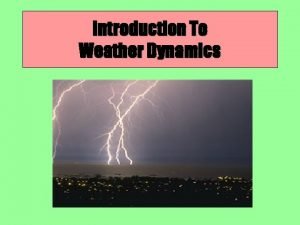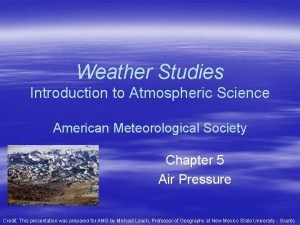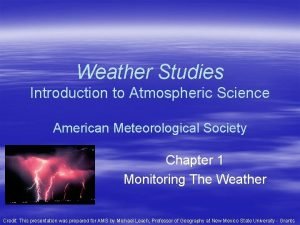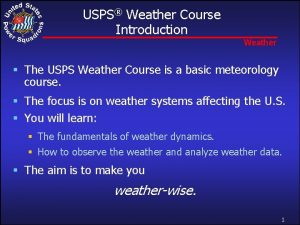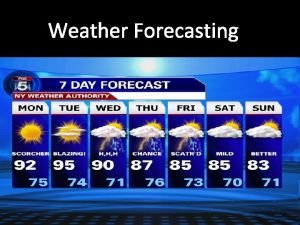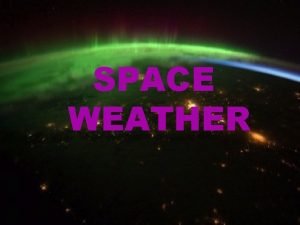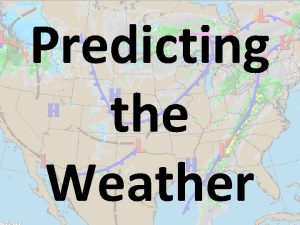INTRODUCTION TO WEATHER WHAT IS WEATHER Weather is









- Slides: 9

INTRODUCTION TO WEATHER

WHAT IS WEATHER? • Weather is the short term state of the atmosphere including temperature, humidity, precipitation, wind, and visibility. • Weather is the condition of the atmosphere at a certain time and place. • It is affected by the amount of water in the air. • In order to understand weather you must be able to understand how the water cycle works.

WHAT IS HUMIDITY? • When water evaporates from rivers, lakes, oceans, and other sources it becomes water vapor. • Water vapor is water in a gaseous state and it is invisible. • Humidity is the amount of water vapor in the air. • As more water evaporates and turns into water vapor the humidity goes up. • How much water vapor that the air can hold changes as the air temperature changes. • One way to express this is through relative humidity.

WHAT IS RELATIVE HUMIDITY? • The amount of water vapor in the air compared to the maximum amount of water vapor that the air can hold at a certain temperature is know as relative humidity. • As air temperature increases the amount of water vapor that the air can hold increases. • As air temperature decreases the amount of water vapor that the air can hold decreases. • When the air is holding all of the water vapor that it can at a given temperature it is said to be saturated. • Since relative humidity is expressed as a percentage saturated air is said to have a relative humidity of 100%

HOW CAN I FIND THE RELATIVE HUMIDITY IN AIR THAT IS NOT SATURATED? • If you know the maximum amount of water vapor that the air can hold at a given temperature, and the actual amount of water vapor in the air, then you can use a simple formula to find the relative humidity. • R H=Actual water vapor content (g/m^3) / Saturation water vapor content (g/m^3) x 100%

WHAT IS THE WATER CYCLE • The water cycle is the continuing movement of water from sources on Earth’s surface into the air, over and onto the land, in the ground, and back onto Earth’s surface. • The water cycle involves: • Precipitation • Runoff • Evaporation • Condensation

WHAT ARE THOSE? • Precipitation: This is when water falls from the clouds as rain, snow, sleet, or hail, onto Earth’s surface. • Runoff: Occurs usually from precipitation that flows across land collects in rivers and streams and ends up in the ocean. • Evaporation: This happens when liquid water changes into water vapor • Condensation: This is when water vapor in the air cools down and turns back into a liquid. This is how clouds form.

WHAT ARE CLOUDS AND WHAT ARE THEY MADE OF? • A cloud is a collection of millions of tiny water droplets or ice crystals suspended in the air. • They form when the air is cooled and condensation occurs. • Clouds are classified by their form and by the altitude at which they are found. • There are three main types of clouds: • Cumulus – These are puffy white clouds that have flat bottoms and form when warm air rises. • Stratus – These clouds cover large areas of the sky and can be caused by a gentle lifting of a large body of air into the atmosphere. They form in layers and can often block out the sun. • Cirrus – These clouds are thin and feathery clouds that are found at high altitudes. They form when the wind is strong.

WHAT ARE THE FOUR TYPES OF PRECIPITATION? • Rain is the most common form of precipitation. Rain is produced when the water droplets inside a cloud become big enough to fall. • Sleet forms when rain falls through a layer of freezing air, which causes the rain to freeze in the air, which produces falling ice. • Snow forms when air temperatures are so cold that water vapor changes directly from a gas to a solid. It can be single ice crystals or the crystals can join to form snow flakes. • Hail forms in cumulonimbus clouds when updrafts in the clouds carry the raindrops so high into the cloud that the raindrops freeze and fall.







